
Awarded "Pick of the Best" (in the "Weird" category) by World.Net
A Glimpse Into London's Early Sewers
Reprinted from Cleaner magazine
PART I
BY MARY GAYMAN
Sewer means "seaward" in Old English. London's sewers were open ditches sloped
slightly to drain human wastes toward the River Thames, and ultimately into
the sea. Sewer ditches quickly filled with garbage and human wastes, which
overflowed onto streets, into houses and marketplaces throughout London.
By the late 1500s, King Henry VIII wrote an edict which made each
householder responsible for clearing the sewer passing by their dwelling.
The King also created a special Commission of Sewers to enforce these
rules. However, no money was provided to pay its members. Therefore, the
Commission was not installed until 1622, when it was decided that fines for
non-compliance could be used to fund its activities.
The day-to-day activities are recorded by the Clerk. Every word uttered
before the tribunal was precisely transcribed in the permanent records of the
Commission.
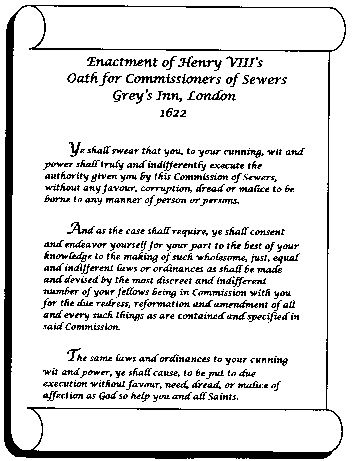 The transcript traces more than 250 years of human misery, due largely
to ignorance of the hazards of poor sanitation. Citizens, physicians,
politicians, inventors and police provided vivid horror stories of "miasmas,
plagues and sudden death" in the homes of London.
By the early 18th Century nearly every residence had a cesspit beneath
the floors. In the best of homes the nauseating stench permeated the most
elegant parlor. Indoor odors were often worse than of the garbage- and manure-
filled streets. While noxious fumes were ignored by most people, it was fear
of "night air" laden with coal smoke and sulfurous industrial fogs which
alarmed the City dweller.
The transcript traces more than 250 years of human misery, due largely
to ignorance of the hazards of poor sanitation. Citizens, physicians,
politicians, inventors and police provided vivid horror stories of "miasmas,
plagues and sudden death" in the homes of London.
By the early 18th Century nearly every residence had a cesspit beneath
the floors. In the best of homes the nauseating stench permeated the most
elegant parlor. Indoor odors were often worse than of the garbage- and manure-
filled streets. While noxious fumes were ignored by most people, it was fear
of "night air" laden with coal smoke and sulfurous industrial fogs which
alarmed the City dweller.
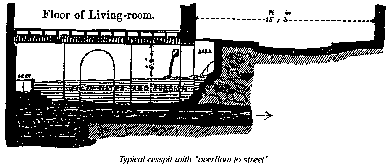 Doors and windows of homes and factories were sealed shut at sunset to
protect occupants form entry of the feared "night air." Entire families and
crews of workers died of mysterious "asphyxiation" during the night. Doctors
had no explanation for lingering illnesses and these sudden "miasmas"
occurring in the City. Vivid descriptions of horrible deaths were routinely
reported at Commission hearings and in the London tabloids.
Most fatalities and injuries described were consistent with asphyxiation
by hydrogen sulfide or oxygen deficiency or methane explosions. These
conditions remain common in sewers, septic tanks and confined spaces today.
When cesspits filled to overflow, they were built to drain to the street
by means of a crudely built culvert to a partially open sewer trench in the
center of the street. Cesspit wastes often soaked foundations, walls and
floors of living quarters. The culvert was frequently blocked causing sewage
to spread under buildings and contaminate shallow wells, cisterns and water
ways from which drinking water was drawn.
Many homeowners "stored" huge quantities of "night soil," which had a
cash value as fertilizer for crops. Those who "harvested" cesspit and sewer
wastes had to crawl on hands and knees through the mire and drag wastes to the
surface. Children were often employed to reach the most difficult sections.
Arguments before the commissioners defended the employment of even very small
children for this work, as they were also employed as chimney sweeps.
Cesspit and sewer cleaning not only lead to instant death, but also led
to slow, lingering death.
On January 12, 1849, this report of working conditions was presented to
the Commissioners: "The smell was of the most horrible description, the air
being so foul that explosions and choke damp were frequent. We were very
nearly losing a whole party by choke damp, the last man being dragged out on
his back through two feet of black fetid deposit in a state of insensibility."
On February 21, 1849: "Explosions occurred in two separate locations
where the men had the skin peeled off their faces and their hair singed. In
advancing toward Southampton, the deposit deepens to 2 feet 9 inches, leaving
only 1 foot 11 inches of space in the sewer. At about 400 feet from the
entrance, the first lamp went out and, 100 feet further on, the second lamp
created an explosion and burnt the hair and face of the person holding it."
The Commission resolved that "It shall be laid down as a first principle
that no common sewer should be so small that an ordinary sized man shall not
be able to cleanse it."
Doors and windows of homes and factories were sealed shut at sunset to
protect occupants form entry of the feared "night air." Entire families and
crews of workers died of mysterious "asphyxiation" during the night. Doctors
had no explanation for lingering illnesses and these sudden "miasmas"
occurring in the City. Vivid descriptions of horrible deaths were routinely
reported at Commission hearings and in the London tabloids.
Most fatalities and injuries described were consistent with asphyxiation
by hydrogen sulfide or oxygen deficiency or methane explosions. These
conditions remain common in sewers, septic tanks and confined spaces today.
When cesspits filled to overflow, they were built to drain to the street
by means of a crudely built culvert to a partially open sewer trench in the
center of the street. Cesspit wastes often soaked foundations, walls and
floors of living quarters. The culvert was frequently blocked causing sewage
to spread under buildings and contaminate shallow wells, cisterns and water
ways from which drinking water was drawn.
Many homeowners "stored" huge quantities of "night soil," which had a
cash value as fertilizer for crops. Those who "harvested" cesspit and sewer
wastes had to crawl on hands and knees through the mire and drag wastes to the
surface. Children were often employed to reach the most difficult sections.
Arguments before the commissioners defended the employment of even very small
children for this work, as they were also employed as chimney sweeps.
Cesspit and sewer cleaning not only lead to instant death, but also led
to slow, lingering death.
On January 12, 1849, this report of working conditions was presented to
the Commissioners: "The smell was of the most horrible description, the air
being so foul that explosions and choke damp were frequent. We were very
nearly losing a whole party by choke damp, the last man being dragged out on
his back through two feet of black fetid deposit in a state of insensibility."
On February 21, 1849: "Explosions occurred in two separate locations
where the men had the skin peeled off their faces and their hair singed. In
advancing toward Southampton, the deposit deepens to 2 feet 9 inches, leaving
only 1 foot 11 inches of space in the sewer. At about 400 feet from the
entrance, the first lamp went out and, 100 feet further on, the second lamp
created an explosion and burnt the hair and face of the person holding it."
The Commission resolved that "It shall be laid down as a first principle
that no common sewer should be so small that an ordinary sized man shall not
be able to cleanse it."
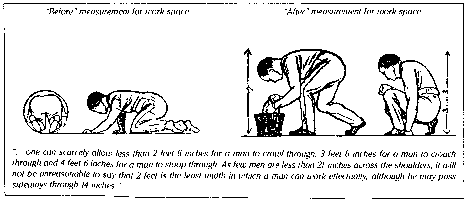 After hearing thousands of such reports, Commissioners hired a team of
physicians to inspect work sites, measure sewer workers, and develop sketches
showing what sewers sizes were needed to provide access for maintenance. They
reviewed not only the actual size of work space needed for the passage of the
worker, but also measured the depth of wastes accumulated in the sewers and
drainage culverts. The recommendations and drawings submitted brought
awareness of the plight of those engaged in sewer and cesspit cleaning.
After hearing thousands of such reports, Commissioners hired a team of
physicians to inspect work sites, measure sewer workers, and develop sketches
showing what sewers sizes were needed to provide access for maintenance. They
reviewed not only the actual size of work space needed for the passage of the
worker, but also measured the depth of wastes accumulated in the sewers and
drainage culverts. The recommendations and drawings submitted brought
awareness of the plight of those engaged in sewer and cesspit cleaning.
Draining London's Sewage Swamp
The streets of London lie 30 feet below the surface of the Thames at high
tide. The city housed more than two million people in crowded conditions and
the situation was deteriorating daily. Epidemics of cholera, typhus,
"consumption" and other undefined maladies plagued the City over at least four
centuries.
Edwin Chadwick, a sanitary reformer of the era, struggled with upper
class apathy toward these horrible conditions. Chadwick explored sewers,
questioned slum dwellers, and turned out hundreds of reports to the
Commission. He experimented with the benefits of obtaining pure water from
lakes and reservoirs, rather than the fetid Thames. His Public Health Act
ultimately reversed the tide of death.
He chastised residents of London for defying the Law of Moses, often
pointing out that it "forbade even an open camp be defiled with human ordure,
and expressly ordained that it should be deposited at a distance and
immediately covered with soil."
He attacked the greed of homeowners stating: "Early in the progress of
these investigations, the proposed system of cleansing, by removal of the
ordure in suspension in waste, was objected to on the grounds of supposed loss
of money received for manure."
The Commission argued that removal of night soils was no longer
profitable, and that "police must be employed to prevent the cleaner from
emptying cesspit ordure into gully-shoots in its highly concentrated and
dangerous state." (Illegal dumping!)
The construction of large central covered sewers had already begun in
1844, even though no plan had yet been drawn to replace cesspits. However, due
to the uneconomic and dangerous practices in cleaning them, the Commission
proposed temporary use of "moveable recepticals" (porta-potties!) such as were
being used in Paris at the time.
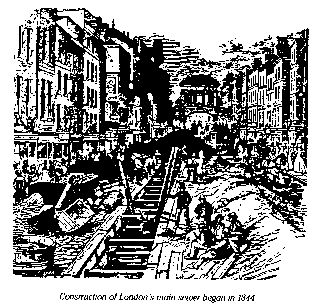 Meanwhile, engineers were hard at work devising a system of drainage
which would carry the wastes of 2 million people out of the area, in
compliance with Mosaic law.
Commissioners allowed experimentation with the "soil-pan or watercloset
principle" and the "tubular mode of drainage" in cities and hamlets throughout
England.
Though Sir Thomas Crapper had not perfected his invention, the
Commission had received hundreds of less functional designs for its
consideration. The "water closet" concept was, as yet, unwieldy.
A complete system of "tubular drains" were yet to be constructed to
"carry immediately away ass solid or semi-solid matter," as the Commissioned
envisioned.
In 1858 "The Great Stink," from the backed up Thames, caused thousands
to flee the City, while Parliament remained in session. Windows of the
parliament building were draped with curtains soaked in chloride of lime, to
prevent closing of the Government. Upper class residents fled the city or
drenched sheets with perfumes to mask the odor from the outside.
Aging Sir Marc Isambard Brunel, together with his son Isambard Kingdom
Brunel, submitted a plan to drain London to the lower side of the river by
building a 1,600 foot tunnel under the Thames. Their audacious plan relied on
constructing a 25 foot diameter shield behind which 9 men, donkeys and carts
would work to remove earth and transport soil to the surface. The huge 25 foot
diameter bore sloped from 35 feet under the river bed to 121 feet on the far
side.
Desperate for any solution, the Commissioners sanctioned the project. If
successful, the Brunels would achieve what no one had ever attempted before.
Work proceeded rapidly and, surprisingly, the project was completed
without a single loss of life, though the younger Brunel was nearly killed in
a collapse of shoring just a few feet from the entry of the excavation.
When Queen Victoria learned of the success, she was so enthralled with
the idea of traveling beneath the Thames that she ordered a small scale rail
with open cars be constructed so that the entire Parliament could accompany
her at the dedication journey through the tunnel.
The public followed Victoria's enthusiasms. By popular demand, the sewer
tunnel was transformed into a fashionable promenade for Londoners. Victoria's
railway became a tourist attraction. Gaslights and walkways were installed and
small stalls lined the tunnel to provide souvenirs for visitors who paid a
small toll to walk under the mighty river. Today, the tunnel is part of
London's famous underground system called the "Bakerloo Line."
The "railroading" of Brunel's triumph drew even greater awareness and
support to the need for better living conditions as London's population
swelled to nearly 3 million.
The light at the end of the tunnel grew gradually larger.
The "hydrolic benefits of tubular drains" and central sewers were
promoted by the Commission to Parliament. Special reservoirs of water
constructed to "cleanse" existing sewers helped, but it became more and more
evident that smooth interior surfaces and adequate slope were needed to
provide smooth movement of wastes through the system.
Meanwhile, engineers were hard at work devising a system of drainage
which would carry the wastes of 2 million people out of the area, in
compliance with Mosaic law.
Commissioners allowed experimentation with the "soil-pan or watercloset
principle" and the "tubular mode of drainage" in cities and hamlets throughout
England.
Though Sir Thomas Crapper had not perfected his invention, the
Commission had received hundreds of less functional designs for its
consideration. The "water closet" concept was, as yet, unwieldy.
A complete system of "tubular drains" were yet to be constructed to
"carry immediately away ass solid or semi-solid matter," as the Commissioned
envisioned.
In 1858 "The Great Stink," from the backed up Thames, caused thousands
to flee the City, while Parliament remained in session. Windows of the
parliament building were draped with curtains soaked in chloride of lime, to
prevent closing of the Government. Upper class residents fled the city or
drenched sheets with perfumes to mask the odor from the outside.
Aging Sir Marc Isambard Brunel, together with his son Isambard Kingdom
Brunel, submitted a plan to drain London to the lower side of the river by
building a 1,600 foot tunnel under the Thames. Their audacious plan relied on
constructing a 25 foot diameter shield behind which 9 men, donkeys and carts
would work to remove earth and transport soil to the surface. The huge 25 foot
diameter bore sloped from 35 feet under the river bed to 121 feet on the far
side.
Desperate for any solution, the Commissioners sanctioned the project. If
successful, the Brunels would achieve what no one had ever attempted before.
Work proceeded rapidly and, surprisingly, the project was completed
without a single loss of life, though the younger Brunel was nearly killed in
a collapse of shoring just a few feet from the entry of the excavation.
When Queen Victoria learned of the success, she was so enthralled with
the idea of traveling beneath the Thames that she ordered a small scale rail
with open cars be constructed so that the entire Parliament could accompany
her at the dedication journey through the tunnel.
The public followed Victoria's enthusiasms. By popular demand, the sewer
tunnel was transformed into a fashionable promenade for Londoners. Victoria's
railway became a tourist attraction. Gaslights and walkways were installed and
small stalls lined the tunnel to provide souvenirs for visitors who paid a
small toll to walk under the mighty river. Today, the tunnel is part of
London's famous underground system called the "Bakerloo Line."
The "railroading" of Brunel's triumph drew even greater awareness and
support to the need for better living conditions as London's population
swelled to nearly 3 million.
The light at the end of the tunnel grew gradually larger.
The "hydrolic benefits of tubular drains" and central sewers were
promoted by the Commission to Parliament. Special reservoirs of water
constructed to "cleanse" existing sewers helped, but it became more and more
evident that smooth interior surfaces and adequate slope were needed to
provide smooth movement of wastes through the system.
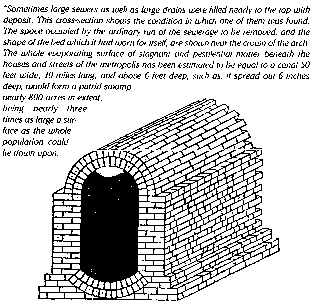 The commissioners believed Sir Thomas Crapper's flush toilet was the
final connection required "to flush away London's problems."
They enthusiastically believed that "with a properly constructed sewer,
combined with supplies of water, no deposit will be occasioned and
obstructions would become so rare as to need no special provision for
cleaning."
* * *
Mary Gayman's formal education in English and Journalism, along with her
active role in three family-owned septic and sewer businesses over the past 25
years, provides a wealth of material for her writing. Mary realizes that
practical field knowledge, backed with solid resource data, is essential in
meeting today's complex business challenges.
Republished courtesy of Cleaner Magazine, published by Cole Publishing Inc., POB 220, Three Lakes WI 54562, tel. 800-257-7222 or 715-546-3346) and author Mary Gayman.
The commissioners believed Sir Thomas Crapper's flush toilet was the
final connection required "to flush away London's problems."
They enthusiastically believed that "with a properly constructed sewer,
combined with supplies of water, no deposit will be occasioned and
obstructions would become so rare as to need no special provision for
cleaning."
* * *
Mary Gayman's formal education in English and Journalism, along with her
active role in three family-owned septic and sewer businesses over the past 25
years, provides a wealth of material for her writing. Mary realizes that
practical field knowledge, backed with solid resource data, is essential in
meeting today's complex business challenges.
Republished courtesy of Cleaner Magazine, published by Cole Publishing Inc., POB 220, Three Lakes WI 54562, tel. 800-257-7222 or 715-546-3346) and author Mary Gayman.
 Return to the Sewer History area of the SwopNet Engineering Databank
Return to the Sewer History area of the SwopNet Engineering Databank
There you will find Parts 2 and 3 of the Sewers of London history, along with a link to the Thomas Crapper Page.
Joseph Bazalgette
was the Father of London Sewers. You can read his story
here.

The transcript traces more than 250 years of human misery, due largely to ignorance of the hazards of poor sanitation. Citizens, physicians, politicians, inventors and police provided vivid horror stories of "miasmas, plagues and sudden death" in the homes of London. By the early 18th Century nearly every residence had a cesspit beneath the floors. In the best of homes the nauseating stench permeated the most elegant parlor. Indoor odors were often worse than of the garbage- and manure- filled streets. While noxious fumes were ignored by most people, it was fear of "night air" laden with coal smoke and sulfurous industrial fogs which alarmed the City dweller.
Doors and windows of homes and factories were sealed shut at sunset to protect occupants form entry of the feared "night air." Entire families and crews of workers died of mysterious "asphyxiation" during the night. Doctors had no explanation for lingering illnesses and these sudden "miasmas" occurring in the City. Vivid descriptions of horrible deaths were routinely reported at Commission hearings and in the London tabloids. Most fatalities and injuries described were consistent with asphyxiation by hydrogen sulfide or oxygen deficiency or methane explosions. These conditions remain common in sewers, septic tanks and confined spaces today. When cesspits filled to overflow, they were built to drain to the street by means of a crudely built culvert to a partially open sewer trench in the center of the street. Cesspit wastes often soaked foundations, walls and floors of living quarters. The culvert was frequently blocked causing sewage to spread under buildings and contaminate shallow wells, cisterns and water ways from which drinking water was drawn. Many homeowners "stored" huge quantities of "night soil," which had a cash value as fertilizer for crops. Those who "harvested" cesspit and sewer wastes had to crawl on hands and knees through the mire and drag wastes to the surface. Children were often employed to reach the most difficult sections. Arguments before the commissioners defended the employment of even very small children for this work, as they were also employed as chimney sweeps. Cesspit and sewer cleaning not only lead to instant death, but also led to slow, lingering death. On January 12, 1849, this report of working conditions was presented to the Commissioners: "The smell was of the most horrible description, the air being so foul that explosions and choke damp were frequent. We were very nearly losing a whole party by choke damp, the last man being dragged out on his back through two feet of black fetid deposit in a state of insensibility." On February 21, 1849: "Explosions occurred in two separate locations where the men had the skin peeled off their faces and their hair singed. In advancing toward Southampton, the deposit deepens to 2 feet 9 inches, leaving only 1 foot 11 inches of space in the sewer. At about 400 feet from the entrance, the first lamp went out and, 100 feet further on, the second lamp created an explosion and burnt the hair and face of the person holding it." The Commission resolved that "It shall be laid down as a first principle that no common sewer should be so small that an ordinary sized man shall not be able to cleanse it."
After hearing thousands of such reports, Commissioners hired a team of physicians to inspect work sites, measure sewer workers, and develop sketches showing what sewers sizes were needed to provide access for maintenance. They reviewed not only the actual size of work space needed for the passage of the worker, but also measured the depth of wastes accumulated in the sewers and drainage culverts. The recommendations and drawings submitted brought awareness of the plight of those engaged in sewer and cesspit cleaning.
![]() Return to the Sewer History area of the SwopNet Engineering Databank
Return to the Sewer History area of the SwopNet Engineering Databank